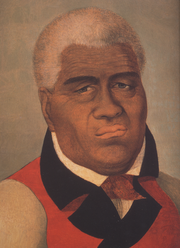
House of Kamehameha
Encyclopedia
The House of Kamehameha (Hale O Kamehameha), or the Kamehameha Dynasty, was the reigning family of the Kingdom of Hawaii
between the unification of the islands by Kamehameha I
in 1810 and the death of Kamehameha V
in 1872. Their most important contributions were the institution of a constitutional form of government, abolition of ancient Hawaiian kapu
systems in favor of westernized laws, proclamation of the Edict of Toleration
giving freedom of religion and the promulgation of the Great Mahele
, allowing private ownership of land for the first time in Hawaii.
 The dynasty developed from royalty of the Kona district
The dynasty developed from royalty of the Kona district
of Hawaii Island
.
They suppported chief Kamehameha in gradually taking over control of first the other parts of the island of Hawaii, and then the other islands of the Hawaiian Islands
archipelago.
His father was Keōua Kalanikupuapakalaninui
the Chief of Kona, and his mother was Kekuiapoiwa
niece of the reigning King Alapai. Relations were wide: for example, Kamehameha's father had also been the father of Kekuiapoiwa, the wife of his son's rival Kīwalaʻō and both were parents of Kamehameha's most sacred wife Keōpūolani
.
Kamehameha himself descended also from Alii Aimoku of Oahu, Maui, Kauai, and Molokai since the princely or chief class (alii) of the islands was rather intermarried, and legendarily all descended, chief Wākea
the original star-born chief.
The influence of the foreigners took a toll on the Kamehamehas. Alcoholism and foreign diseases which the Native Hawaiians had no immunity to were the main reason for the demise of the Kamehamehas. No monarch except Kamehameha I lived past the age of 42. Kamehameha III ruled for 30 years only because he came to the throne as a child. He died in 1854 at the age of 41.
Kamehameha V named his sister Princess Victoria Kamāmalu Kaahumanu
heir, but she died in 1866. After the death of Kamehameha V in 1872 who had not named another heir, the dynasty ended. On his deathbed, he might have offered the throne to Bernice Pauahi Bishop
who refused, and died an hour later. The Chiefs and Nobles nominated William Lunalilo who became the first elected monarch of the Hawaiian Kingdom. He was the son of Charles Kanaina and Miriam Auhea Kekauluohi, a niece of Kamehameha I through her father Kalaimamahu, Kamehameha I's half-brother.
, were to use the estate
for the education of the native Hawaiian people. He founded Bishop Museum
and Kamehameha Schools
. He made preparations for Bishop Estate to continue after his death which came in 1915. Bishop Estate continues to be a large land holder in Hawaii.
Kingdom of Hawaii
The Kingdom of Hawaii was established during the years 1795 to 1810 with the subjugation of the smaller independent chiefdoms of Oahu, Maui, Molokai, Lānai, Kauai and Niihau by the chiefdom of Hawaii into one unified government...
between the unification of the islands by Kamehameha I
Kamehameha I
Kamehameha I , also known as Kamehameha the Great, conquered the Hawaiian Islands and formally established the Kingdom of Hawaii in 1810. By developing alliances with the major Pacific colonial powers, Kamehameha preserved Hawaii's independence under his rule...
in 1810 and the death of Kamehameha V
Kamehameha V
aloghaKamehameha V , born as Lot Kapuāiwa, reigned as monarch of the Kingdom of Hawaii from 1863 to 1872. His motto was "Onipa`a": immovable, firm, steadfast or determined; he worked diligently for his people and kingdom and was described as the last great traditional chief...
in 1872. Their most important contributions were the institution of a constitutional form of government, abolition of ancient Hawaiian kapu
Kapu
Kapu refers to the ancient Hawaiian code of conduct of laws and regulations. The kapu system was universal in lifestyle, gender roles, politics, religion, etc. An offense that was kapu was often a corporal offense, but also often denoted a threat to spiritual power, or theft of mana. Kapus were...
systems in favor of westernized laws, proclamation of the Edict of Toleration
Edict of Toleration (Hawaii)
An Edict of Toleration was issued by King Kamehameha III of Hawaii on June 17, 1839, which allowed for the establishment of the Hawaii Catholic Church. The Roman Catholic Church was suppressed in the Kingdom of Hawaii during the reigns of Kamehameha and Kamehameha II.During their administrations,...
giving freedom of religion and the promulgation of the Great Mahele
Great Mahele
The Great Mahele or just the Mahele was the Hawaiian land redistribution act proposed by King Kamehameha III in the 1830s and enacted in 1848.-Overview:...
, allowing private ownership of land for the first time in Hawaii.
Origins

Kona District, Hawaii
Kona is the name of a moku or district on the Big Island of Hawaii in the State of Hawaii. In the current system of administration of Hawaii County, the moku of Kona is divided into North Kona District and South Kona District . The term "Kona" is sometimes used to refer to its largest town,...
of Hawaii Island
Hawaii (island)
The Island of Hawaii, also called the Big Island or Hawaii Island , is a volcanic island in the North Pacific Ocean...
.
They suppported chief Kamehameha in gradually taking over control of first the other parts of the island of Hawaii, and then the other islands of the Hawaiian Islands
Hawaiian Islands
The Hawaiian Islands are an archipelago of eight major islands, several atolls, numerous smaller islets, and undersea seamounts in the North Pacific Ocean, extending some 1,500 miles from the island of Hawaii in the south to northernmost Kure Atoll...
archipelago.
His father was Keōua Kalanikupuapakalaninui
Keoua
Keōua Kalanikupuapaikalaninui Ahilapalapa, sometimes called Keōua Nui , was an Ancient Hawaiian noble and the father of Kamehameha I, the first King of united Hawaii...
the Chief of Kona, and his mother was Kekuiapoiwa
Kekuiapoiwa II
Kekuiapoiwa II was a Hawaiian chiefess and the mother of the king Kamehameha I.- Biography :She was named after her aunt Kekuiapoiwa Nui , the wife of King Kekaulike of Maui....
niece of the reigning King Alapai. Relations were wide: for example, Kamehameha's father had also been the father of Kekuiapoiwa, the wife of his son's rival Kīwalaʻō and both were parents of Kamehameha's most sacred wife Keōpūolani
Keopuolani
Kalanikauikaalaneo Kai Keōpūolani-Ahu-i-Kekai-Makuahine-a-Kama-Kalani-Kau-i-Kealaneo was a queen consort of Hawaii and the highest ranking wife of King Kamehameha I.-Early life:...
.
Kamehameha himself descended also from Alii Aimoku of Oahu, Maui, Kauai, and Molokai since the princely or chief class (alii) of the islands was rather intermarried, and legendarily all descended, chief Wākea
Wakea
In Hawaiian mythology, Wākea is the eldest son of Kahiko , and lives in Olalowaia. Wākea is the ancestor of the aristocracy, the ali‘i. The priests and common people come from his brothers. In another legend, Wākea lives in Hihiku and marries Pāpā, also called Pāpā-nui or Pāpā-nui-hanau-moku, who...
the original star-born chief.
Expansion of realm
Kamehameha I started a series of wars of conquest and strategic alliances. Succeeding his brother as Alii of Kohala and Kona in 1782, he set out to unify Hawaii Island, and later to subdue the neighboring islands. He ultimately unified the whole of the Hawaiian islands into a single kingdom by 1810. His descendants ruled until the death of Kamehameha V on December 11, 1872.Kamehameha Monarchs
- Kamehameha IKamehameha IKamehameha I , also known as Kamehameha the Great, conquered the Hawaiian Islands and formally established the Kingdom of Hawaii in 1810. By developing alliances with the major Pacific colonial powers, Kamehameha preserved Hawaii's independence under his rule...
, "The Great", (1795–1819) - Kamehameha IIKamehameha IIKamehameha II was the second king of the Kingdom of Hawaii. His birth name was Liholiho and full name was Kalaninui kua Liholiho i ke kapu Iolani...
, Liholiho, (1819–1824) - Kamehameha IIIKamehameha IIIKamehameha III was the King of Hawaii from 1825 to 1854. His full Hawaiian name was Keaweaweula Kiwalao Kauikeaouli Kaleiopapa and then lengthened to Keaweaweula Kiwalao Kauikeaouli Kaleiopapa Kalani Waiakua Kalanikau Iokikilo Kiwalao i ke kapu Kamehameha when he ascended the throne.Under his...
, Kauikeaouli, (1825–1854) - Kamehameha IVKamehameha IVKamehameha IV, born Alexander Iolani Liholiho Keawenui , reigned as the fourth king of the Kingdom of Hawaii from January 11, 1855 to November 30, 1863.-Early life:...
, Alexander Liholiho, (1854–1863) - Kamehameha VKamehameha ValoghaKamehameha V , born as Lot Kapuāiwa, reigned as monarch of the Kingdom of Hawaii from 1863 to 1872. His motto was "Onipa`a": immovable, firm, steadfast or determined; he worked diligently for his people and kingdom and was described as the last great traditional chief...
, Lot Kapuāiwa, (1863–1872)
The influence of the foreigners took a toll on the Kamehamehas. Alcoholism and foreign diseases which the Native Hawaiians had no immunity to were the main reason for the demise of the Kamehamehas. No monarch except Kamehameha I lived past the age of 42. Kamehameha III ruled for 30 years only because he came to the throne as a child. He died in 1854 at the age of 41.
Kamehameha V named his sister Princess Victoria Kamāmalu Kaahumanu
Kaahumanu IV
Victoria Kamāmalu Kaahumanu IV , was Kuhina Nui of Hawaii and its crown princess. Princess Kamāmalu is one of Hawaii's less notable historical figures...
heir, but she died in 1866. After the death of Kamehameha V in 1872 who had not named another heir, the dynasty ended. On his deathbed, he might have offered the throne to Bernice Pauahi Bishop
Bernice Pauahi Bishop
Bernice Pauahi Bishop , born Bernice Pauahi Pākī, was a Hawaiian princess, philanthropist, alii, and direct descendant of the royal House of Kamehameha. She was the great-granddaughter of King Kamehameha I and last surviving heir...
who refused, and died an hour later. The Chiefs and Nobles nominated William Lunalilo who became the first elected monarch of the Hawaiian Kingdom. He was the son of Charles Kanaina and Miriam Auhea Kekauluohi, a niece of Kamehameha I through her father Kalaimamahu, Kamehameha I's half-brother.
Current existence
Bishop, who had rejected the offer of becoming the ruling monarch, was the last living heiress to the House of Kamehameha and died in 1884. Her dying wishes to her husband, Charles Reed BishopCharles Reed Bishop
Charles Reed Bishop was a businessman and philanthropist in Hawaii.Born in Glens Falls, New York, he sailed to Hawaii in 1846 at the age of 24, and made his home there. Bishop was one of the first trustees of and a major donor to the Kamehameha Schools in Hawaii...
, were to use the estate
Estate (law)
An estate is the net worth of a person at any point in time. It is the sum of a person's assets - legal rights, interests and entitlements to property of any kind - less all liabilities at that time. The issue is of special legal significance on a question of bankruptcy and death of the person...
for the education of the native Hawaiian people. He founded Bishop Museum
Bishop Museum
The Bishop Museum , is a museum of history and science in the historic Kalihi district of Honolulu on the Hawaiian island of O'ahu...
and Kamehameha Schools
Kamehameha Schools
Kamehameha Schools , formerly called Kamehameha Schools/Bishop Estate , is a private co-educational college-preparatory institution that specializes in Native Hawaiian language and cultural education. It is located in Hawaii and operates three campuses: Kapālama , Pukalani , and Keaau...
. He made preparations for Bishop Estate to continue after his death which came in 1915. Bishop Estate continues to be a large land holder in Hawaii.

